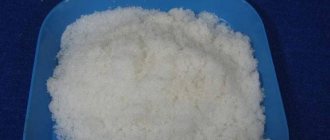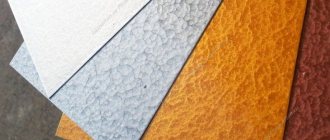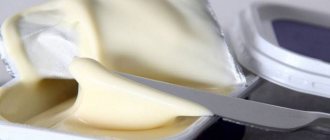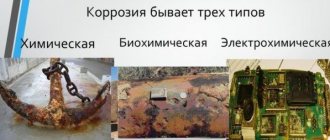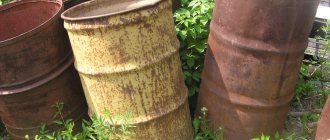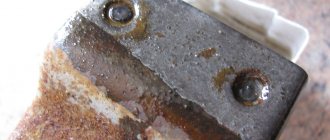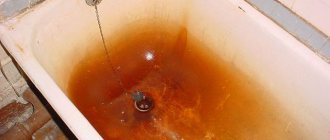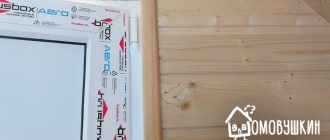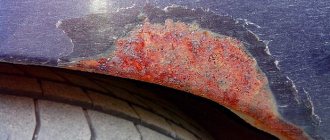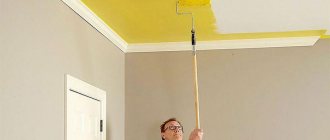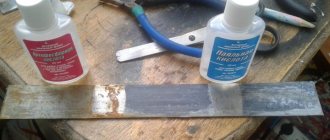The appearance of “saffron milk caps” on the car body is an extremely dangerous problem that requires an immediate solution. Otherwise, the metal under the chips will begin to succumb to oxidation, and the scratches will increase in size and deepen. Through holes will appear on the surface, and the body will lose its attractive appearance and strength. As a result, a seemingly harmless speck of rust will cause the need to completely replace the damaged part.
In addition, if you decide to sell a corroded car, do not count on a good deal: the cost of the car will drop by 2 or even 3 times. Therefore, you will have to replace the rusting elements, and this procedure is neither quick nor cheap.
It is very difficult to stop the development of the corrosion process, but in less advanced cases it is possible. The most common method for removing rust stains on a car body is to treat them with phosphoric acid.
What is phosphoric acid and how is it used?
Orthophosphoric acid is a powder that is diluted with water and is used in various industries, as well as medicine. The acid is used in diluted form, 85% aqueous solution, which does not have a pungent odor. The acid is used in the production of household products that are used to remove rust. It is also added to primer mixtures for metal. After treating the surface with orthophosphoric acid, a protective layer is formed that prevents the material from destruction.
Basic precautions when working with phosphoric acid
When removing rust chemically, it is necessary to protect the respiratory tract and hands; for this, use a respirator and gloves. Since the evaporation of acid can cause burns to the respiratory tract and skin. In addition, the product is a fire hazard, so when working it is necessary to ensure good ventilation in the room. If acid gets on the skin, you must immediately rinse the area with plenty of water for about 15 minutes. If the damage is significant, you should immediately visit the hospital. Do not wipe the product with a napkin or towel.
How to properly remove rust using phosphoric acid
The advantage of phosphoric acid is that it removes loose rust and also forms a thin layer that serves as protection. The acid is capable of corroding rust and providing a protective film in the form of an oily surface.
Methods for removing rust depend on the degree of damage:
- cleansing of elements by complete immersion in the product;
- surface treatment using a roller or spray;
- applied to metal products after mechanical cleaning.
Tips for choosing a rust remover
When choosing a product to remove traces of corrosion, you need to proceed from the situation. If you plan to clean surfaces using the immersion method, you will need a lot of acid. In this case, it is recommended to purchase 85% phosphoric acid. If there is a need not only to remove rust, but also to create a protective film under the paint, then you won’t be able to make the solution yourself. In this situation, it is more correct to purchase a factory-made converter, which contains all the necessary additives.
In addition, you need to know whether the surface is planned to be primed. Converter-modifiers improve the inhibitory and hydrophobic qualities of the primer composition, but still do not belong to primers. In such cases, priming converters will help, after processing, with which a paint and varnish composition can be applied to the surface.
Purification of elements by complete immersion in phosphoric acid
If you have a sufficient amount of the product, you can use the full immersion method to remove rust. To do this, you first need to degrease the element to be cleaned using a detergent composition, and then wash it thoroughly. After this, pour 100 grams of an 85% acid solution into the prepared container and add 1 liter of water. The element to be cleaned is immersed in the solution for one hour, stirring the product periodically. Then the product must be removed and washed well. After such cleaning, the product is washed with another solution consisting of 50% water, 2% ammonia and 48% alcohol. Then the product is washed again with plain water and dried. All stages must be performed in strict sequence. If you do not degrease the product, the cleaning will be uneven, since the product may not corrode normal stains, and additional cleaning will be required. In this way, you can clean any products with varying degrees of rust, but the thicker the coating, the more time you need to keep the element in the solution. If the element is not dried after washing, hydroxide appears on it. Drying can be done using any method.
When is it necessary to adjust the pH value of a nutrient solution?
In hydroponics, pH adjustment is usually done in three cases:
Read also: Invoice for advance payment (advance payment)
1) when preparing a nutrient solution of normal concentration for direct use (which in English is called the final solution
);
2) when preparing a nutrient solution concentrate for long-term storage (which in English is called stock solution
); 3) when the acidity of the nutrient solution poured into the container changes significantly over time (for example, by 0.5 or 1 pH unit or more per day).
Cleaning rust by applying phosphoric acid to the surface
If the product cannot be immersed due to its size or there is a small amount of product available, then the method of applying acid to the surface with a spray, roller or brush is used. But first it is necessary to indicate the extent of the damage.
If there is significant plaque, you must first remove the top layer using a grinder and a metal brush. Then the surface is degreased and a solution of orthophosphoric acid is sprayed. In this case, the solution should be applied to the entire affected surface, without gaps. After two hours, wash the area with a neutral solution. At the end, a final rinse is performed and the treated area is thoroughly dried.
If the rust layer is small, you can skip cleaning with a brush, but immediately begin degreasing and applying the solution. But re-spraying may be required if cleaning is not complete.
Using orthophosphoric acid, you can clean bathtubs, washbasins and toilets; it completely cleans rusty deposits on enamel surfaces. For products made of acrylic material, such cleaning is not acceptable.
For enameled and earthenware products, you need to dilute 100 grams of acid with 500 milliliters of water. First, the surface is degreased using a detergent and thoroughly cleaned from household contaminants. Then apply acid and wash it off with soda solution. To do this, dilute 1 spoon of soda in a liter of water. In this case, no friction is produced, as a result the enamel surface retains its integrity.
When using acid, do not allow it to come into contact with the skin, otherwise it is necessary to rinse the area with water for a long time.
Production process
In laboratory conditions it is obtained:
- Dissolving phosphorus (V) oxide in water when heated.
- Hydrolysis of phosphorus pentachloride in hot water.
- When concentrated nitric acid reacts with white phosphorus.
The industry uses thermal and extraction (sulfuric acid) methods. The thermal method, which allows to achieve the greatest purity of the product, includes the following stages:
- Oxidation of elemental phosphorus by combustion in excess air to produce tetraphosphorus decaoxide (phosphoric anhydride).
- Hydration and absorption of its vapors in special towers.
- Condensation of the resulting acid with the capture of mist from the gas phase.
The extraction method uses the reaction of sulfuric acid decomposition of natural salts with a yield of up to 95%. Process stages:
A mixture of sulfuric acid and natural phosphate, the so-called. The pulp is fed from the hopper into the extractor - a steel lined vat with a stirrer.- In 4 hours, the pulp heated to 90 °C successively passes through several such reactors. As a result, phosphoric acid is formed and calcium sulfate crystallizes.
- To separate, the pulp enters a perforated belt with a filter cloth, and through its holes the finished product is collected into a vacuum chamber.
How to properly store and transport phosphoric acid
Phosphoric acid is an aggressive agent, so it is necessary to follow certain rules when transporting and storing this substance. The powder must be placed in an airtight container. To prevent foreign elements from getting into the acid, all containers must be used clean and dry, then the prepared solution will be of high quality.
Preparing a low-quality composition can result in dangerous vapor poisoning or lack of the desired result. Store containers with acid in a dry and warm place where there is no dampness or condensation. There is no need to pour the powder into another container; it is better to leave it in the original packaging. Such cargo is considered dangerous, so special documentation is required to transport it over long distances.
Recommendations for cleaning products with phosphoric acid
Cleaning is done with care so that the metal surface does not become too thin and holes are formed. During preliminary mechanical cleaning, disks with large elements cannot be used, otherwise significant damage to the surface can be caused.
Before starting the main work, the remaining surface must be covered with film, since exposure to such a strong product may damage the rest of the coating. Therefore, processing must be carried out carefully so that the damaged surface does not have to be restored, which will lead to additional costs.
If the work is done correctly, the result is a reliable and durable surface that does not contain rust stains, which lead to the destruction of metal products.
When applying orthophosphoric acid to a surface, it is necessary to wear gloves and a respirator; they serve as means of protection against the harmful substance. If acid gets on clothing, it must be removed immediately so that the product does not get on the skin and cause a burn.
Main signs of pancreatic enzyme deficiency
Identifying enzyme deficiencies is quite simple. The key symptoms are heaviness after eating, a feeling of fullness in the abdomen and abdominal discomfort. Often these symptoms are accompanied by bloating, rumbling, flatulence, and diarrhea. Most often, such symptoms can occur in ordinary situations: when eating heavy, fatty foods or when overeating, when it was simply impossible to resist eating a lot of tasty dishes. In this case, you should not be afraid of problems with the pancreas or other gastrointestinal diseases. The pancreas simply cannot cope with much work and may need help.
Why does diarrhea occur? Fats are the most difficult components of food to digest. If there is a lack of enzymes in the body, it is with the processing of fats that difficulties arise. As a result, undigested fats that are not decomposed by enzymes contribute to a change in the nature of the stool and the rapid movement of contents along the intestines, which provokes diarrhea8.
Basic rules when using phosphoric acid to remove rust
- Before starting the main work, it is necessary to prepare all protective equipment, since the substance is aggressive and leaves burns if it comes into contact with the skin.
- First, the surface must be cleaned of normal contaminants so that the product can perform its functions fully, otherwise the surface will be cleaned in parts.
- If the rust layer is too thick, then it is necessary to resort to mechanical cleaning of the surface; for this, use a grinder and a metal brush.
- The cleansing area must be degreased and then rinsed with water so that the product adheres well and works effectively.
- After finishing the cleansing, the acid must be washed off with a neutral solution and then with water.
- Since the substance is aggressive, it can damage the main surface, so it must be covered with film.
- If it is not possible to clean by immersion, then use sprayers or apply acid with a brush or roller to the rusty surface.
- If the surface is not clean after the first application, additional spraying will be required. After this, the area to be cleaned must be washed with a neutral solution and then with water.
- Phosphoric acid cannot be used to clean rust on acrylic surfaces.
Benefits of Phosphoric Acid for Rust Removal
- Orthophosphoric acid removes rusty deposits well on enamel and earthenware products, on metal surfaces, and is actively used in the automotive industry.
- Using this product you can remove rust without rubbing the surface, this helps preserve the enamel.
- Phosphoric acid forms a film on the cleaned area, which serves to protect the surface from new corrosion and other damage.
- This acid can be used to clean bathtubs, toilets and washbasins, as well as other household appliances that have a similar surface.
- Phosphoric acid helps remove rust stains and subsequently protect the surface from corrosion damage.
When working with acid, it is necessary to wear protective equipment, a respirator and gloves, as the substance is aggressive. Before applying acid, the surface must be degreased using detergents, then rinsed well with water, and then sprayed with acid. After the required time has passed, the acid is washed off with a neutral solution based on alcohol, ammonia and water. After this, the surface is washed with water and dried. If the rust layer is too thick, then it must first be cleaned with a metal brush or grinder with a special attachment. The work must be performed in the correct sequence; if you skip at least one step, this will lead to poor quality cleaning.
Can citric or acetic acid be used to lower pH?
It is possible, but it is not necessary, because it is completely ineffective. The fact is that citric and acetic acids belong to the category of weak organic acids, the ions of which serve as food for microorganisms living in the solution. Therefore, despite the fact that these acids do lower the pH of the solution, the change will not be sustainable: the fungi and bacteria inhabiting the solution will quickly eat the citrate / acetate ions formed as a result of the breakdown of these acids, and after a few hours the pH will return to its previous (higher) value.
